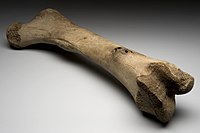
Photo from wikipedia
An important factor in periodontitis pathogenesis relates to a network of interactions of various cytokines. Thrombospondin-1 (TSP-1) is upregulated in several inflammatory diseases. We previously found that Porphyromonas gingivalis lipopolysaccharide… Click to show full abstract
An important factor in periodontitis pathogenesis relates to a network of interactions of various cytokines. Thrombospondin-1 (TSP-1) is upregulated in several inflammatory diseases. We previously found that Porphyromonas gingivalis lipopolysaccharide (P. gingivalis LPS)-induced TSP-1 production, and that TSP-1 simultaneously and effectively elevated inflammatory cytokines in THP-1 macrophages. This suggests that TSP-1 plays an important role in the pathology of periodontitis. However, the function of TSP-1 on oral cells is largely unknown. This study aimed to elucidate the underlying molecular mechanisms of TSP-1 in human periodontal fibroblasts (hPDLFs). We demonstrated that TSP-1 is highly expressed in the gingival crevicular fluid of patients with chronic periodontitis and in the inflammatory gingival tissues of rats. TSP-1 overexpression or treatment with recombinant human TSP-1(rTSP-1) promoted the expression of MMP-2, MMP-9 and RANKL/OPG in hPDLFs, while anti-TSP-1 inhibited cytokines production from P. gingivalis LPS-treated hPDLFs. Additional experiments showed that SB203580 (a special p38MAPK inhibitor) inhibited MMP-2, MMP-9 and RANKL/OPG expression induced by rTSP-1. Thus, TSP-1 effectively promoted P. gingivalis LPS-induced periodontal tissue (extracellular matrix (ECM) and alveolar bone) destruction by the p38MAPK signalling pathway, indicating that it may be a potential therapeutic target against periodontitis.
Journal Title: International immunopharmacology
Year Published: 2021
Link to full text (if available)
Share on Social Media: Sign Up to like & get
recommendations!